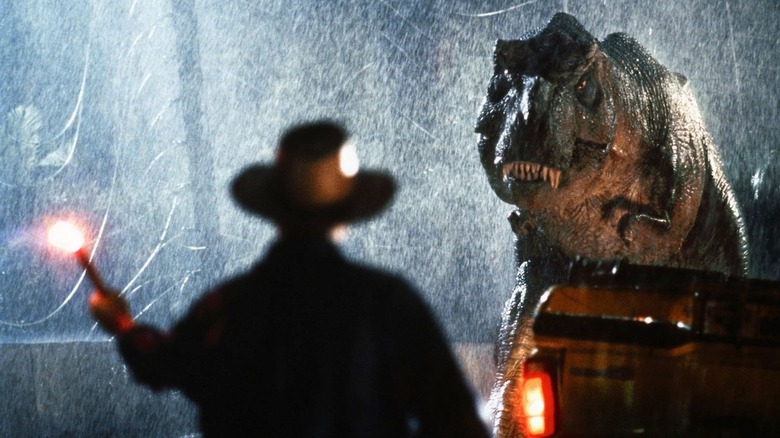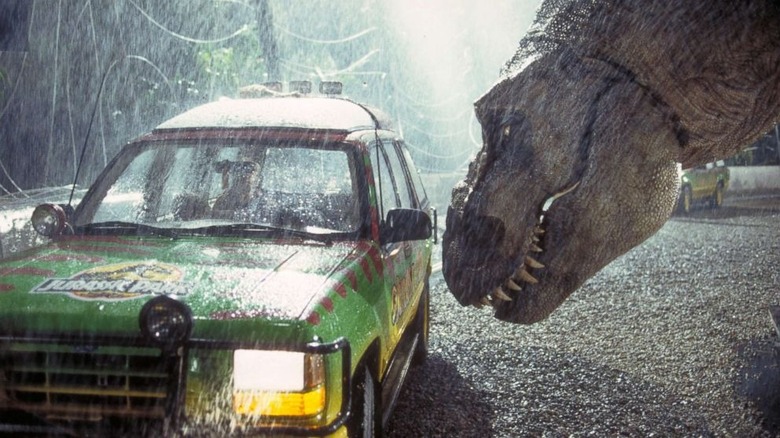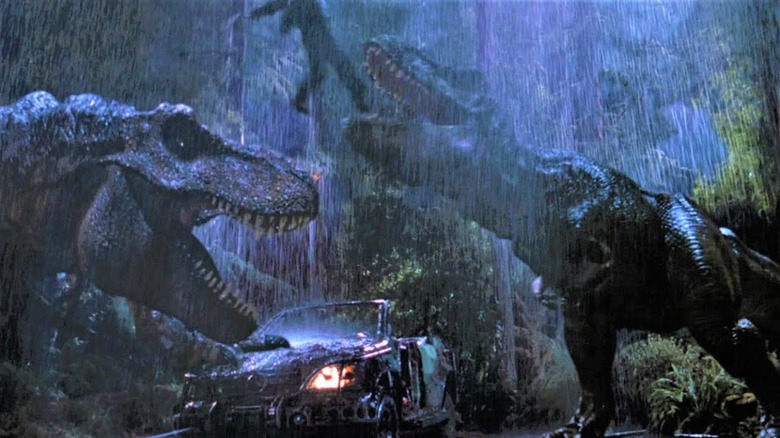Jurassic Park's T-Rex Had One Flaw — It Wasn't Waterproof
There's no question that Industrial Light & Magic's work on 1993's "Jurassic Park" was groundbreaking stuff, proving once and for all that computer-generated imagery was here to stay in cinema. Yet the dinosaurs in the film were not wholly created by ILM — in fact, Stan Winston Studios was just as responsible (if not more so) in bringing the dinos to life, creating numerous puppets and animatronic versions of the dinosaur characters seen in the film.
The crowning achievement of Winston and his team for the film is the Tyrannosaurus Rex, an imposing figure which is so essential to the film that the movie's entire marketing campaign revolved around it. Winston, looking to top his already impressive track record with creature creation (which included the 14-foot tall Alien Queen in 1986's "Aliens"), developed a 36-foot-long, 18-foot-tall puppet of the T-Rex that weighed about 12,000 pounds and required a custom space to be created just to store it.
However, changes to the script during pre-production — the period during which the massive puppet had to be designed and constructed — meant that Winston and his team soon faced a huge Achilles heel for their creation. In "Jurassic Park," the T-Rex is first seen escaping her pen while a tropical storm hits Isla Nublar, which of course means that a torrential downpour of rain occurs throughout the scene. Unfortunately, Winston and co. had not waterproofed the giant creature, resulting in a filming experience that involved lots of frequent touch-ups to the star dinosaur.
Don't get the T-Rex wet (and don't feed her after midnight, probably)
As the Stan Winston Studio team continued to build their animatronic masterpiece, they were justifiably proud of the way it looked and operated. At least, they were until the fateful day when they discovered that rain was going to be a big part of the lengthy scene where the T-Rex escapes. As puppeteer John Rosengrant recalled as part of an oral history of the film in 2013:
"We're talking about a hydraulically powered creature that felt like a bus going by you when it would move. We found out not long before we were going to shoot that it was going to be raining [in the scene]. So it went from this beautifully tuned machine that worked fantastically to ... suddenly the foam-rubber skin started absorbing water, and now all of the calculations were off and it started to shudder."
The only fix the effects crew could think of without starting from scratch was to dry the T-Rex out, which required a whole team of people to tend to the creature off-camera. Rosengrant recalled how the crew "went out and bought tons of towels and started putting big blowers, dryers on it to dry it out." Speaking to ABC News in 2018, Rosengrant added: "There was a night shift that would come in to continue the process of drying the T-Rex so he'd be ready for his next day."
Stan Winston himself remembered the ordeal as well: "Lots of long nights with blow dryers and fans ... drying it out, squeezing it out. It was nuts ... after the shot was done, everyone would run to the T-Rex and just start mopping it off with towels."
Building a better T-Rex
Drenched or not, the T-Rex became a star thanks to "Jurassic Park." And, ironically, her arrival was forever tied to the iconography of rippling water. When 1997's "The Lost World: Jurassic Park" came around, John Rosengrant and the rest of the Stan Winston Studio crew knew the types of challenges they were to face, along with the fact that director Steven Spielberg would want to drown the T-Rex — multiple T-Rexes, actually — in a downpour once again.
As Rosengrant explained in 2012, "We had discovered on 'Jurassic Park' that there wasn't a lot of need for a head-to-tail T-Rex. Because this creature was so huge, shots that were wide enough to show the whole body became CG shots. And shots that used our T-Rex rig were close enough that you only saw the head and about half its body in the frame." In addition, the crew developed a new foam rubber skin coated with silicone, the better to waterproof their new T-Rex rigs.
Thanks to some trial-and-error — and apparently, a helluva lot of towels — the T-Rex off-camera had finally become what the T-Rex had always been on-camera: flawless.


